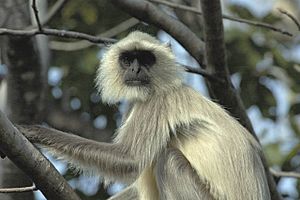Colobine monkeys facts for kids
Quick facts for kids Colobine monkeys |
|
|---|---|
 |
|
| A langur | |
| Scientific classification | |
| Kingdom: | |
| Class: | |
| Order: | |
| Superfamily: | |
| Family: | |
| Subfamily: |
Colobinae
|
Colobine monkeys are a special group of Old World monkeys. They are a "subfamily," which is like a smaller family within a larger one. There are about 59 different kinds, or species, of colobine monkeys. These species belong to 10 different groups called genera.
Some well-known colobine monkeys include the black-and-white Colobus monkeys, the proboscis monkey with its big nose, and the grey langurs. The word "langur" actually means 'having a long tail,' which is a good description for many of these monkeys!
Scientists sometimes group colobine monkeys in different ways. One common way is to split them into two main groups. The three types of colobine monkeys found in Africa – Colobus, Piliocolobus, and Procolobus – are put into one group. These African monkeys are special because they have very short, "stub" thumbs.
The many types of colobine monkeys found in Asia are placed into one or two other groups. Studies of their DNA show that the Asian species form two clear groups. One group includes the langurs, and the other includes the "odd-nosed" species like the proboscis monkey. Interestingly, the grey langurs are not closely related to either of these main Asian groups.
What Makes Them Special?
Colobine monkeys are medium-sized primates. They usually have long tails and come in many different colors. What's really cool is that almost all baby colobine monkeys have a very different color from their parents. This helps them stand out when they are young!
Most colobines live in trees, which means they are arboreal. However, some kinds spend more time on the ground, making them terrestrial. You can find them in many different places, from steamy rainforests and mangrove swamps to cool mountain forests and open grasslands called savannahs. But you won't find them in deserts or very dry areas. Colobines live in groups, but the size and structure of these groups can be different depending on the species.
Their Diet
Colobine monkeys are mostly folivorous. This means their main food source is leaves! Leaves can be hard to digest, so colobines have a special stomach. It has many chambers, like a cow's stomach, which helps them break down tough leaves. This makes them the only ruminant primates. A ruminant is an animal that digests its food in a special way, often by chewing it more than once.
Besides leaves, colobines might also eat flowers, fruits, and sometimes even an insect or two. Unlike another group of Old World monkeys called the Cercopithecinae, colobines do not have cheek pouches. These pouches are like little pockets inside their cheeks that other monkeys use to store food.
Babies and Life
A baby colobine monkey grows inside its mother for about six to seven months. The young monkeys drink their mother's milk for about a year. They become fully grown when they are between three and six years old. Colobine monkeys can live for about 20 years.
Images for kids
-
Colobines are mainly arboreal (tree-dwelling) and folivorous (leaf-eating) primates.
See also
 In Spanish: Colobinos para niños
In Spanish: Colobinos para niños


